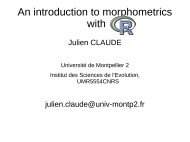Protocols for field and laboratory rodent studies - HAL
Protocols for field and laboratory rodent studies - HAL
Protocols for field and laboratory rodent studies - HAL
Create successful ePaper yourself
Turn your PDF publications into a flip-book with our unique Google optimized e-Paper software.
<strong>Protocols</strong> <strong>for</strong> <strong>field</strong> <strong>and</strong> <strong>laboratory</strong> <strong>rodent</strong> <strong>studies</strong>42List of figuresFigure 1: Location of the seven CERoPath sampling sites in South-East Asia ....................................................... VFigure 2: Hunter with traditional trap in Phrae, Thail<strong>and</strong> (Photo: Herbreteau V.) ..................................................... 3Figure 3: A multiple-capture cage-trap in Cambodia (Photo: Herbreteau V.) ........................................................... 3Figure 4: Preparation of collars mounted on a wooden stick, in Kalasin province, Thail<strong>and</strong> (Photo: Herbreteau V.)3Figure 5: GPS receiver with integrated GIS software (Photo: Herbreteau V.) .......................................................... 5Figure 6: Tubes <strong>for</strong> dissection (Photo: Herbreteau V.) ............................................................................................. 7Figure 7: Prepare Bleach, water <strong>and</strong> ethanol <strong>and</strong> replace regularly (Photo: Herbreteau V.) .................................... 7Figure 8: Material used <strong>for</strong> euthanasia (Photo: Herbreteau V.) ................................................................................ 8Figure 9: Sucking louse drawn By Pearson Scott Foresman (Public domain), not scaled. ...................................... 9Figure 10: Flea drawn by Robert Hooke's in his Micrographia (Public domain), not scaled. .................................... 9Figure 11: Tick drawn By Pearson Scott Foresman (Public domain), not scaled. .................................................... 9Figure 12: Mite drawing (from www.l<strong>and</strong>careresearch.co.nz), not scaled ................................................................ 9Figure 13 : Tissue paper stuck under the cage to collect ectoparasites (Photo: Herbreteau V.) .............................. 9Figure 14 : Collection of from the euthanasia container be<strong>for</strong>e inspection of animal (Photo: Herbreteau P.) .......... 9Figure 15 : Use of a comb to collect more ectoparasites on the animal (Photo: Herbreteau P.) .............................. 9Figure 16 : Ticks attached to the ear (Photo: Herbreteau V.) ................................................................................... 9Figure 17: Cardiac puncture (Photo: Herbreteau P.) .............................................................................................. 11Figure 18: Example of microcentrifuge suitable to realize serum in a <strong>field</strong> <strong>laboratory</strong> (Photo: Herbreteau V.) ....... 12Figure 19: Liquid nitrogen tank suitable <strong>for</strong> <strong>field</strong> use (Photo: Herbreteau V.) ......................................................... 12Figure 20: Tubes used <strong>for</strong> blood collection (EDTA, serum <strong>and</strong> coagulation tubes) (Photo: Herbreteau V.) ........... 12Figure 21 : Blotting papers drying (Photo: Herbreteau P.)...................................................................................... 12Figure 22: Whatman FTA ® Card ............................................................................................................................ 13Figure 23: Dissection steps A to G (Photos: Herbreteau P.) .................................................................................. 14Figure 24: Dissection steps H to M (Photo: Herbreteau P.) .................................................................................... 15Figure 25: Example of organization of the <strong>field</strong> <strong>laboratory</strong> (CERoPath project, Nan province, 06/2008) (Photo:Mor<strong>and</strong> S.) ............................................................................................................................................................. 17Figure 26: Examples of hemoparasites on Giemsa stained blood smear (Photos: Desquesnes M.) ..................... 18Figure 27: Capillary tubes <strong>and</strong> observation of the buffy coat area (Photo: Desquesnes M.) .................................. 18Figure 28: Sampling urine (Photo: Herbreteau P.) ................................................................................................. 19Figure 29: Sampling tracheal mucus (Photo: Herbreteau P.) ................................................................................. 19Figure 30: Drawing of a Vernier caliper .................................................................................................................. 20Figure 31: Example of measurement with a Vernier caliper ................................................................................... 20Figure 32: Balance used <strong>for</strong> small animals (0.1 g precision) (Photo: Herbreteau V.) ............................................. 20Figure 33: “Head <strong>and</strong> body”, <strong>and</strong> tail measurements (Photo: Herbreteau V.) ........................................................ 21Figure 34: Hind foot measurement not including claw (Photo: Herbreteau P.) ....................................................... 21Figure 35: Ear measurement (Photo: Herbreteau P.) ............................................................................................. 21Figure 36: Skull measurement (Photo: Herbreteau P.) .......................................................................................... 21Figure 37: External comparison of male <strong>and</strong> female reproductive organs (Photo: Herbreteau V.) ......................... 22Figure 38: Position of teats, example of B<strong>and</strong>icota indica (1+2+3) (Photo: Herbreteau V.) ................................... 22Figure 39: Measurement of testicle length (Photo: Herbreteau P.) ........................................................................ 22Figure 40: Developed seminal vesicles in an adult male (Photo: Herbreteau P.) ................................................... 22Figure 41: Comparison between an adult female Rattus exulans (C0207, above) <strong>and</strong> a juvenile female Rattustanezumi (C0206, below), from Veal Renh in South Cambodia (Photo: Herbreteau V.) ........................................ 23Figure 42: Different stages of the third molar (M3) growth (Photo: Chaval Y.) ....................................................... 23Figure 43: Decision tree to determine the maturity of a <strong>rodent</strong>, by considering the third molar growth <strong>and</strong> sexualorgans externally .................................................................................................................................................... 23Figure 44: Skull cleaned <strong>for</strong> morphometrics (Photo: Soonchan S.) ........................................................................ 24Figure 45: Example of l<strong>and</strong>marks on a palatine view of a Rattus sp. skull (Photo: Claude J.) ............................... 24Figure 46: Pseudol<strong>and</strong>mark digitization on first upper molars of R. exulans (Photo: Claude J.). ........................... 24Figure 47: PCR1 agarose gel to differentiate genus Rattus <strong>and</strong> genus B<strong>and</strong>icota (Photo: Chaval Y.) .................. 26Figure 48: PCR2 agarose gel to differentiate species of the genus B<strong>and</strong>icota. (Photo: Chaval Y.) ....................... 26Figure 49: Multiplex PCR agarose gel to differentiate the genus B<strong>and</strong>icota <strong>and</strong> R. tanezumi. (Photo: Chaval Y.) 26Figure 50: Structure of the CERoPath identification tool <strong>and</strong> the links with the virtual museum to present vouchers<strong>and</strong> species in<strong>for</strong>mation (http://www.ceropath.org/barcoding_tool/<strong>rodent</strong>sea). ...................................................... 27Figure 51: CERoPath identification tool based on COI comparison between a user sequence <strong>and</strong> the CERoPathdata set reference (http://www.ceropath.org/barcoding_tool/<strong>rodent</strong>sea) ................................................................ 28Figure 52: Interactive tree generated by the CERoPath identification tool after alignment of unknown sequences............................................................................................................................................................................... 28Figure 53: G-b<strong>and</strong>ed karyotype (Fig A) <strong>and</strong> C-b<strong>and</strong>ed metaphase (Fig B) of a female B<strong>and</strong>icota savilei (R4408)from Thail<strong>and</strong> (Badenhorst et al., 2009). ................................................................................................................ 29Figure 54: Karyotyping from bone marrow (Photo: Herbreteau V.) ........................................................................ 30Figure 55: Cell incubator at CBGP, France (Photo: Xuéreb A.) ............................................................................. 31Figure 56: Scolex of Raillietina sp. with 4 suckers <strong>and</strong> armed rostellum (20x) (Photo: Ribas A. <strong>and</strong> Chaisiri K.) .. 32Figure 57: Filarid worm (Photo: Ribas A. <strong>and</strong> Chaisiri K.) ...................................................................................... 32Figure 58: Notocotylus loeiensis (Photo: Ribas A. <strong>and</strong> Chaisiri K.) ........................................................................ 32Figure 59: Monili<strong>for</strong>mis monili<strong>for</strong>mis with pseudo-segmented body (Photo: Ribas A. <strong>and</strong> Chaisiri K.) ................... 32



